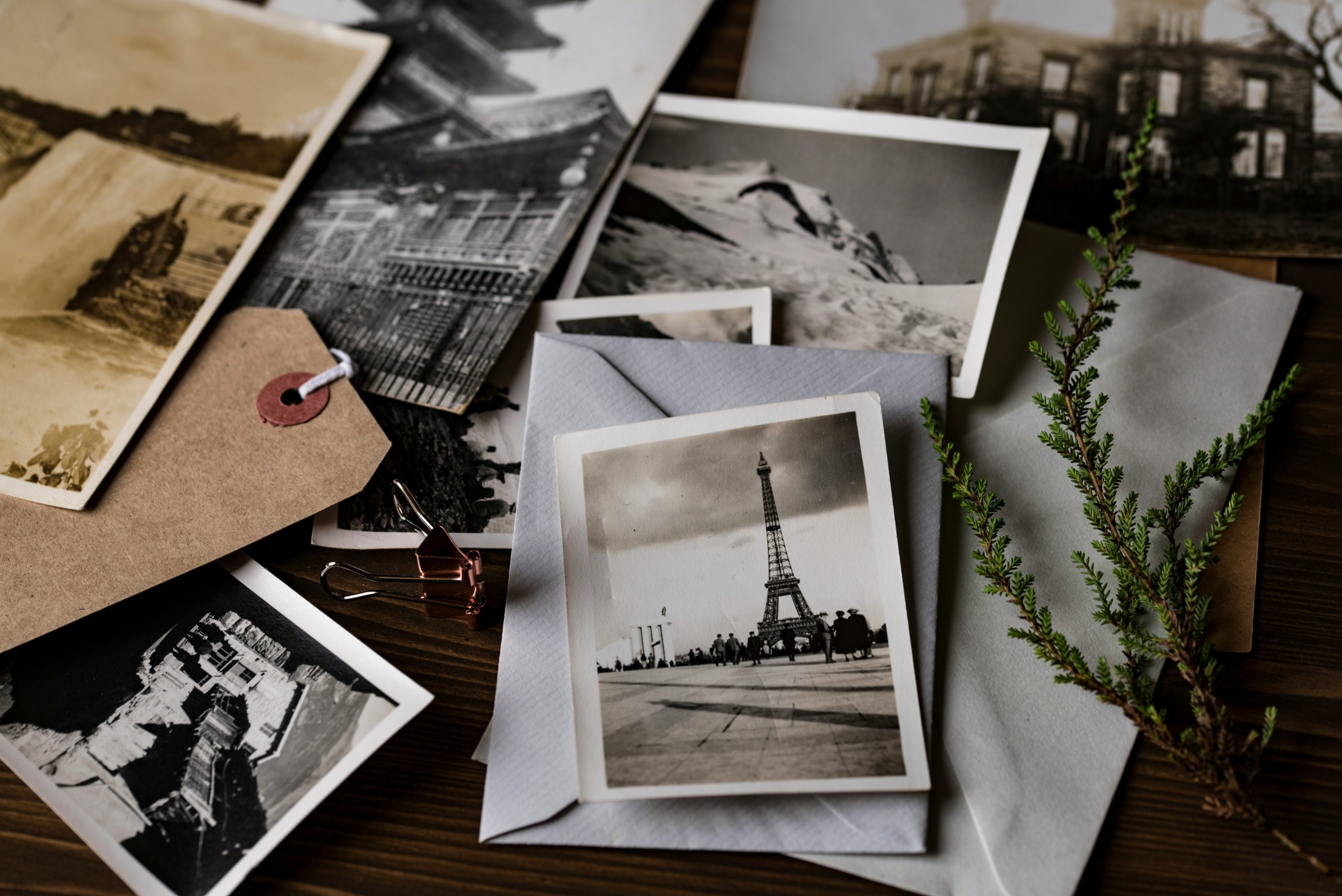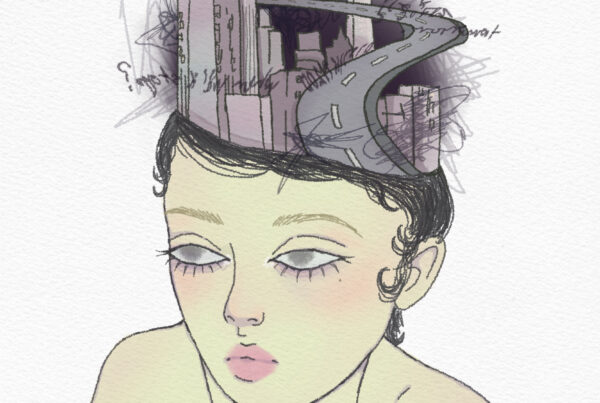
In my grandmother’s home, a cacophony of wooden frames engulf your field of vision the moment you walk through the front door. The frames, if not picked out with conscious deliberations then with warm intent, encompass within them all sorts of wonders – A faded picture of my family in 2008. A wonky pencil drawing of a tree. A copy of my aunt’s university degree. A picture of my smiling grandfather, wiped daily. Encased in a slab of glass, these images carry a meaning that deeply permeates her very essence. Do you think the 15 thousand images on your phone carry the same sort of permanence? And how does the idea of maintaining a legacy, a tangible sense of self in death, contribute to this (im)permanence collusion?
In my grandmother’s home, a cacophony of wooden frames engulf your field of vision the moment you walk through the front door. The frames, if not picked out with conscious deliberations then with warm intent, encompass within them all sorts of wonders – A faded picture of my family in 2008. A wonky pencil drawing of a tree. A copy of my aunt’s university degree. A picture of my smiling grandfather, wiped daily. Encased in a slab of glass, these images carry a meaning that deeply permeates her very essence. Do you think the 15 thousand images on your phone carry the same sort of permanence? And how does the idea of maintaining a legacy, a tangible sense of self in death, contribute to this (im)permanence collusion?

Photo by Joanna Kosinska on Unsplash

Photo by Joanna Kosinska on Unsplash
A mantra of the 21st century could truly be “more is more”. More ads, more trends, more interests, bigger, better, grander aspirations, goals, more consumption, more marketing. This is adjacent to the idea that new is better, that being grounded in the same place is inherently, unequivocally worse than floating from one way of living to the next. Despite this, there is a love for preservation amidst the chaos. People love to preserve their childhood toys, to dote on the cartoons of their childhood (“they just don’t make them the same anymore!”), and to seek out analogue cameras that inherently make photography a more intentional process. This begs the question, does the permanence of a memory rely on the objects we take away from the experience?
Let’s talk souvenirs. A research paper qualitatively assessed the value and motivations behind acquiring souvenirs in travel (Wilkins, 2010). One of the main takeaways informed the function of souvenirs as an ‘aide memoire’, a way of preserving a piece of the experience in reintegration to daily life. A second takeaway indicated a social function, a sort of proof of the experience that can be communicated to others. These motivations for acquiring destination-specific products were also more in line with women’s motivations rather than men’s. Ironically enough, the purpose of the paper was a way for retailers to better market their products. However, these are still valuable insights into the overarching idea of the heightened value of a singular, tangible keepsake rather than a portfolio’s worth of pictures on a phone.
“Permanence inherently breeds meaning -- to choose a photo to look at everyday as you pass by a wall is a testament to that photo’s subjective value to you”
Surely taking photos on a phone cannot be this uninspiring? Apparently, 40 something years into the creation of the digital camera, the intrigue has transformed into a mindless, mundane activity. Evelyne Morlot discusses this phenomenon. The research paper, titled “Nostalgic consumption behaviors among young generations in photography”, addresses the fact that, for a lot of people, “Instagram pictures embody anecdotes or souvenirs of the present and they are a medium which encourages interaction on social communities” (Morlot, 2013). Taking images on the phone has seemed to transform into a social phenomenon, the primary aim being to share it with your community. The increasing interest in using analog cameras, however, is linked to giving value to the photographic experience, aiming to achieve unique self-expression. Most interestingly, respondents of the research paper unanimously stated that physical images carry more emotion and meaning than virtual images. A printed picture, created artistically and intentionally using a non-digital camera, with no primary intent of sharing it on social media, seems to be the winner of the sentiment and value competition. Permanence inherently breeds meaning — to choose a photo to look at everyday as you pass by a wall is a testament to that photo’s subjective value to you, something that the digital space does not achieve in its clutter of the same cookie-cutter images.
What about taking it a step further? Does the permanence of our very existence depend on what we leave behind? In other words, creating a legacy, ‘an enduring post-mortem reputation’ (Waggoner et al., 2023). Two main theories are most pervasive in this largely unresearched realm: one theory postulates the social connectivity function of maintaining a legacy, maintaining social belonging even after death. The second expands on the status-related aspect of maintaining a legacy, a sort of external status confirmation of who you were and where you stood in life (Waggoner et al., 2023). Brett Wagoner’s thought experiment summarizes these ideas well:
“Consider two scenarios. In the first, you have a life filled with love and meaning and enough money to get by comfortably. However, after you die, something terrible is revealed about you – which may not even be true – and people come to despise you. In the second, you have a life of relative hardship and obscurity, but after you die, it is revealed that you were an incredibly talented artist and your reputation is assured forever. Which option would you choose?” (Feehly, 2023)
The answer seems to be the second option.
Legacy can come about in many shapes: achievements, monetary forms, physical objects and clothes to pass down. Most commonly, legacy lies in having children, more specifically in passing down your wisdom and experiences to the next generation. One cannot ignore the evolutionary factor for maintaining a legacy; in this case, the biological drive for reproduction goes hand in hand with our social constructions of passing down knowledge, the most valuable legacy there is.
“the biological drive for reproduction goes hand in hand with our social constructions of passing down knowledge, the most valuable legacy there is.”
Self-esteem and identity cannot be untangled from legacy needs – research indicates that the need for social belonging in death can also come about from a cognitive dissonance and death anxiety. Grasping the inevitability of death and attaching symbolic meaning to personal existence are equally important in maintaining peace and managing anxieties associated with what comes post-mortem (Waggoner et al., 2023). We want to feel like we matter, that the lives we touched amounted to something, that our experiences and thoughts and keep-sakes have value and a function that extends beyond ourselves. To impact a community with your presence, even in death, can be seen as one of life’s greatest achievements, one you will never experience while alive. “All of the philanthropy you see — the buildings named after people for giving $50 million to this museum or to Columbia — is a result of one man after another trying to conquer his mortality.”
In this pursuit of a lasting legacy, I find myself thinking that the view from my own hill is blurry. As a twenty-something in the midst of self-discovery, perhaps the cognitive dissonance resolves itself with a natural creation of self-image, which can only be sculpted as it passes longer through the test of time. Sifting through your belongings and thoughts and achievements and memories, there is a comfort in these things making up who you are. Your feats and quirks will one day be caught in the tongues of your greater community, the one you helped define, build and nourish. Maybe it’s time to tidy up the camera roll? I, for one, am planning on adding a photo of my grandma and I to her permanent collection. <<
References
– Feehly, C. (2023, October 13). The desire for legacy is a mental glitch but we can use it for good. New Scientist. https://www.newscientist.com/article/mg26034600-200-the-desire-for-legacy-is-a-mental-glitch-but-we-can-use-it-for-good/
– Morlot, E. M. (2013). Nostalgic consumption behaviours among young generations in photography. A comparative approach of Instagram and analogue photography. [MA Thesis]. Umeå School of Business and Economics.
– Waggoner, B., Bering, J. M., & Halberstadt, J. (2023). The desire to be remembered: A review and analysis of legacy motivations and behaviors. New Ideas in Psychology, 69, 101005. https://doi.org/10.1016/j.newideapsych.2022.101005
– Wilkins, H. (2010). Souvenirs: What and why we buy. Journal of Travel Research, 50(3), 239–247. https://doi.org/10.1177/0047287510362782
A mantra of the 21st century could truly be “more is more”. More ads, more trends, more interests, bigger, better, grander aspirations, goals, more consumption, more marketing. This is adjacent to the idea that new is better, that being grounded in the same place is inherently, unequivocally worse than floating from one way of living to the next. Despite this, there is a love for preservation amidst the chaos. People love to preserve their childhood toys, to dote on the cartoons of their childhood (“they just don’t make them the same anymore!”), and to seek out analogue cameras that inherently make photography a more intentional process. This begs the question, does the permanence of a memory rely on the objects we take away from the experience?
Let’s talk souvenirs. A research paper qualitatively assessed the value and motivations behind acquiring souvenirs in travel (Wilkins, 2010). One of the main takeaways informed the function of souvenirs as an ‘aide memoire’, a way of preserving a piece of the experience in reintegration to daily life. A second takeaway indicated a social function, a sort of proof of the experience that can be communicated to others. These motivations for acquiring destination-specific products were also more in line with women’s motivations rather than men’s. Ironically enough, the purpose of the paper was a way for retailers to better market their products. However, these are still valuable insights into the overarching idea of the heightened value of a singular, tangible keepsake rather than a portfolio’s worth of pictures on a phone.
“Permanence inherently breeds meaning -- to choose a photo to look at everyday as you pass by a wall is a testament to that photo’s subjective value to you”
Surely taking photos on a phone cannot be this uninspiring? Apparently, 40 something years into the creation of the digital camera, the intrigue has transformed into a mindless, mundane activity. Evelyne Morlot discusses this phenomenon. The research paper, titled “Nostalgic consumption behaviors among young generations in photography”, addresses the fact that, for a lot of people, “Instagram pictures embody anecdotes or souvenirs of the present and they are a medium which encourages interaction on social communities” (Morlot, 2013). Taking images on the phone has seemed to transform into a social phenomenon, the primary aim being to share it with your community. The increasing interest in using analog cameras, however, is linked to giving value to the photographic experience, aiming to achieve unique self-expression. Most interestingly, respondents of the research paper unanimously stated that physical images carry more emotion and meaning than virtual images. A printed picture, created artistically and intentionally using a non-digital camera, with no primary intent of sharing it on social media, seems to be the winner of the sentiment and value competition. Permanence inherently breeds meaning — to choose a photo to look at everyday as you pass by a wall is a testament to that photo’s subjective value to you, something that the digital space does not achieve in its clutter of the same cookie-cutter images.
What about taking it a step further? Does the permanence of our very existence depend on what we leave behind? In other words, creating a legacy, ‘an enduring post-mortem reputation’ (Waggoner et al., 2023). Two main theories are most pervasive in this largely unresearched realm: one theory postulates the social connectivity function of maintaining a legacy, maintaining social belonging even after death. The second expands on the status-related aspect of maintaining a legacy, a sort of external status confirmation of who you were and where you stood in life (Waggoner et al., 2023). Brett Wagoner’s thought experiment summarizes these ideas well:
“Consider two scenarios. In the first, you have a life filled with love and meaning and enough money to get by comfortably. However, after you die, something terrible is revealed about you – which may not even be true – and people come to despise you. In the second, you have a life of relative hardship and obscurity, but after you die, it is revealed that you were an incredibly talented artist and your reputation is assured forever. Which option would you choose?” (Feehly, 2023)
The answer seems to be the second option.
Legacy can come about in many shapes: achievements, monetary forms, physical objects and clothes to pass down. Most commonly, legacy lies in having children, more specifically in passing down your wisdom and experiences to the next generation. One cannot ignore the evolutionary factor for maintaining a legacy; in this case, the biological drive for reproduction goes hand in hand with our social constructions of passing down knowledge, the most valuable legacy there is.
Self-esteem and identity cannot be untangled from legacy needs – research indicates that the need for social belonging in death can also come about from a cognitive dissonance and death anxiety. Grasping the inevitability of death and attaching symbolic meaning to personal existence are equally important in maintaining peace and managing anxieties associated with what comes post-mortem (Waggoner et al., 2023). We want to feel like we matter, that the lives we touched amounted to something, that our experiences and thoughts and keep-sakes have value and a function that extends beyond ourselves. To impact a community with your presence, even in death, can be seen as one of life’s greatest achievements, one you will never experience while alive. “All of the philanthropy you see — the buildings named after people for giving $50 million to this museum or to Columbia — is a result of one man after another trying to conquer his mortality.”
In this pursuit of a lasting legacy, I find myself thinking that the view from my own hill is blurry. As a twenty-something in the midst of self-discovery, perhaps the cognitive dissonance resolves itself with a natural creation of self-image, which can only be sculpted as it passes longer through the test of time. Sifting through your belongings and thoughts and achievements and memories, there is a comfort in these things making up who you are. Your feats and quirks will one day be caught in the tongues of your greater community, the one you helped define, build and nourish. Maybe it’s time to tidy up the camera roll? I, for one, am planning on adding a photo of my grandma and I to her permanent collection. <<



